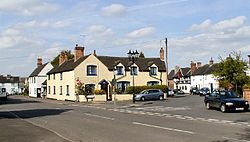Aston-on-Trent
| Aston-on-Trent | |
| Derbyshire | |
|---|---|

| |
| Location | |
| Grid reference: | SK415295 |
| Location: | 52°51’36"N, 1°23’6"W |
| Data | |
| Population: | 1,682 (2011) |
| Post town: | Derby |
| Postcode: | DE72 |
| Dialling code: | 01332 |
| Local Government | |
| Council: | South Derbyshire |
| Parliamentary constituency: |
South Derbyshire |
Aston-on-Trent is a village and parish in southern Derbyshire, adjacent to the border with Leicestershire. The civil parish had a population of 1,682 at the 2011 Census.[1] It is adjacent to Weston-on-Trent and near Chellaston.
On the north bank of the River Trent, about a mile from the river on rising ground, it is out of its flood plain. The Trent and Mersey Canal runs between the village and the river.
All Saints’ Church is Celtic. There are two public houses, the White Hart and the Malt Shovel.
History
In 1009 Æþelræd Unræd (King Ethelred the Unready) signed a charter at the Great Council which recognised the position and boundaries of Westune.[2] The land described in that charter included the lands now known as Shardlow, Great Wilne, Church Wilne, Crich, Smalley, Morley, Weston and Aston on Trent. Under this charter Æþelræd gave his minister, Morcar, a number of rights that made him free from tax and enabled his own rule within the manor.[3]
This manor came under the control of the King again following Morcar being murdered in 1015 and the lands were later given to Ælfgar, the Earl of Mercia, but he lost this at the Norman Conquest. Aston is in the Domesday book where it is mentioned as an outlying farm of Weston-on-Trent and listed amongst the lands given to Henry de Ferrers[4] by the King. The land given to Henry[5] included five acres of land that was valued at eight shillings.
The name is of Anglo-Saxon descent ('ton' an Old English suffix meaning farm). Being in the east, the name literally means 'East Farm'.[2][6] The 'On-Trent' suffix of both Aston and nearby villages simply means they are near the river Trent.
Shardlow and Great Wilne form a township in the ancient parish of Aston-on-Trent. Having built their own church in Sharlow in 1838, it formed a separate ecclesiastical parish, and in 1866 a separate civil parish.[2]
Notable residents
General Sir Drury-Lowe was born here and William Darwin Fox was born nearby. Edward Holden, Joseph Greaves and James Sutton were High Sheriffs of Derbyshire. See also below for three England footballers.
Education
The village has its own infant and junior school and is in the catchment area of Chellaston School.
Recreation
Aston-on-Trent was the birthplace of three men who all played football for England within a six-year spell. They were Harry Linacre (1881–1957), who was a goalkeeper for England and Nottingham Forest, and his uncles Fred and Frank Forman.[7] Harry was picked for England twice in 1905 helping them to victory both times. All three men were also originally signed by Derby County and then sold on to Nottingham Forest.
References
- ↑ "Civil Parish population 2011". Neighbourhood Statistics. Office for National Statistics. http://www.neighbourhood.statistics.gov.uk/dissemination/LeadKeyFigures.do?a=7&b=11120215&c=Aston+upon+Trent&d=16&e=62&g=6414796&i=1001x1003x1032x1004&m=0&r=1&s=1458402898281&enc=1. Retrieved 19 March 2016.
- ↑ 2.0 2.1 2.2 Aston on Trent Conservation Area History, South Derbyshire, accessed 25 November 2008
- ↑ Charter of Æthelred, The Great Council, 1009, accessible at Derby records
- ↑ Domesday Book: A Complete Translation. London: Penguin, 2003. p. 749 ISBN 0-14-143994-7
- ↑ Henry de Ferrers held a considerable number of manors including a massive number in Nottinghamshire given to him by the King. These included obviously Aston on Trent, but also included Barrow upon Trent, Breaston, Chellaston, Etwall, Hungry Bentley, Markeaton, Normanton, Spondon and Swarkestone
- ↑ "Ashton Upon Trent". Key to English Place-names. English Place Name Society / Institute of Name Studies at the University of Nottingham. http://kepn.nottingham.ac.uk/map/place/Derbyshire/Aston%20upon%20Trent. Retrieved 22 August 2013.
- ↑ Harry Linacre, englandfootballonline.com, Retrieved 12 March 2016
Outside links
| ("Wikimedia Commons" has material about Aston-on-Trent) |